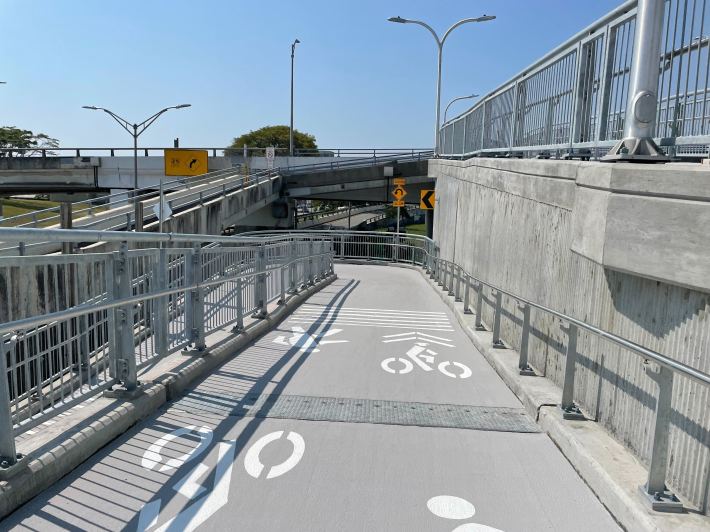One bridge down, six to go.
The Cross Bay Bridge is 100 percent accessible to both pedestrians and cyclists now that the treacherous ramp touching down on the Rockaway side has been replaced by a gently sloping ramp.
Where previously cyclists and pedestrians had to negotiate a ramp made up of two straight, sharp-angled pieces including one large steep main section, the new ramp gently curves twice, allowing anyone in a wheelchair or on a bike to have much more control of their speed going downhill, and a much easier time going uphill.

The new ramp is also slightly wider, giving pedestrians and cyclists 10 feet of space compared to eight feet on the old ramp.
The MTA lifted the cycling ban on the Cross Bay Bridge in late 2022, but cyclists were required to walk their bikes on the ramp on the Rockaway side. With the completion of the ramp, the Cross Bay Bridge is now the first bridge in the MTA's portfolio that is 100 percent legally accessible for cyclists.
The ramp upgrade was part of the MTA's bike and pedestrian access plan, an effort to make it easier to walk and bike to, from and on the transit agency's bridges, trains and buses, something state legislators tasked the agency with in 2021. One of the primary architects of the 2021 law celebrated the new ramp as proof the plan was working.
"It's not every day you see your legislative accomplishments have real impacts," said Assembly Member Jessica Gonzalez-Rojas (D-Queens). "I'm excited about the ADA-accessible ramp on the Cross Bay Bridge and that cyclists and pedestrians can access this space where they would have been able to in the past, because we passed my legislation, the MTA Bike Access bill in 2021. Our city is big enough for all of us and I'll continue to do all I can to improve transit access, public health and expand environmentally-friendly modes of transportation."
Since the bike-pedestrian access law was passed, the MTA has responded by making plans to make it easier and safer to walk and bike on three of the seven bridges it owns in the city: the Cross Bay Bridge, the Henry Hudson Bridge and the Triboro Bridge.
On the Henry Hudson Bridge, the MTA is replacing the current narrow pedestrian path on the bottom deck of the bridge with an eight-foot wide path that will have room for cyclists, along with a cantilevered path on the souther portion of the bridge that provides better access for wheelchair users, set to open in 2025.
The MTA also has a number of plans for the multiple spans of the Triboro Bridge. On the northern side of the piece of the bridge that connects Queens and Randall's Island, the agency is going to replace the existing pedestrian path ad the stairs on the Astoria entrance of the bridge with a new 10-foot wide shared-use path that conforms to the Americans With Disabilities Act by 2027. The MTA has also built a new ramp connecting the Triboro and the upcoming East Harlem greenway expansion in Manhattan, and is supposed to open a new ADA-accessible ramp connecting Randall's and the Bronx by the end of the year.
The future is murkier for the rest of the MTA's bridges. The agency has said it will really study, for real this time, the feasibility of a pedestrian and cyclist path on the Verrazzano Bridge, but has previously sandbagged the effort with ridiculous and expensive designs in order to bury the effort.
Similarly, the agency has offered a vague promise to look at what can be done to upgrade cycling access on the Gil Hodges-Marine Parkway Bridge, which currently has a narrow walkway on the west side of the bridge where cycling is technically illegal but where people ride their bikes anyway.
The MTA hasn't offered up any ideas for refurbishing the Bronx-Whitestone or Throgs Neck bridges, two Robert Moses behemoths that were built with no thought for anyone but drivers. Cycling advocates praised the agency for moving quickly on the projects they initially promised, though said pieces of the MTA still could stand to embrace new ways of thinking.
"In general, the MTA is doing great on bridges," said Jon Orcutt, the director of comms for Bike New York. "They went right to work, and they're getting stuff done and open. If they're able to do capital work, it seems like money and the willpower is no obstacle. But if you talk to them about, say, doing a lane conversion, they're back in the 1980s. The Brooklyn Bridge has more traffic per lane than the Verrazzano does [and] the city still managed to do take a lane."






